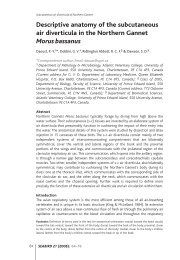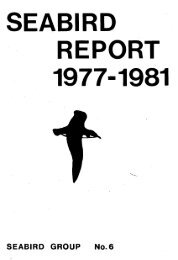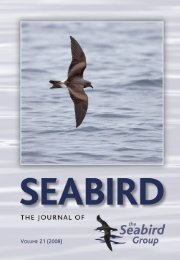You also want an ePaper? Increase the reach of your titles
YUMPU automatically turns print PDFs into web optimized ePapers that Google loves.
2001 Return rates of Common Terns 181<br />
Birds fledged<br />
100%<br />
75%<br />
50%<br />
25%<br />
0%<br />
1 ( 83) 2 (235) 3 (198)<br />
Number of fledged siblings<br />
<strong>No</strong> return<br />
Figure 1. Proportion of fledged Common Terns with known number of fledglings per<br />
brood that were resighted in the natal colony (absolute numbers of returned<br />
and non-returned birds in brackets).<br />
Figuur 1. Percentage uitgevlogen jonge Visdieven met bekend aantal uitgevlogen<br />
nestgenootjes dat na verloop van tijd terugkeerde als hoopvolle broedvogel in<br />
de kolonie (totale aantallen teruggekeerde en niet-teruggekeerde aantallen<br />
vogels).<br />
From 1992 onwards, all chicks were marked with subcutaneously<br />
injected passive transponders before fledging (Becker & Wendeln 1997). <strong>The</strong>se<br />
transponders sent an individual alphanumeric code when activated by special<br />
antennae placed on resting platforms (see above) around the colony, thereby<br />
allowing identification of birds for their whole life without retrapping (Becker &<br />
Wendeln 1997). <strong>The</strong> antennae were active continuously throughout the seasons.<br />
All antennae (1993-94: 12; 1995-96: 22; 1997-98: 30; 1999-2000: 35) were<br />
distributed equally among the platforms and their positions were changed<br />
regularly at intervals of 2-3 days in order to record the presence of marked birds<br />
at all platforms. Using these methods we recorded with a high probability all<br />
marked birds that returned to their home colony. Only chicks from broods in<br />
which three chicks hatched were used for the analysis, so that the number of<br />
chicks raised to fledging would serve as an index of parental quality. In this<br />
study, 215 fledglings from the years 1992-1997 with known information about<br />
hatching position or the number of fledged siblings and re-encountered up to the<br />
end of the breeding season in 2000 were compared with 307 fledglings that did<br />
not return to date. To test for an influence of either hatching order or of number<br />
of fledged siblings on return rates we performed two-tailed Chi-square tests. For<br />
testing for combined effects on return rates of both hatching order and number<br />
Return








